2014 marks the centenary of military aviation in Australia. To commemorate this I am writing a six-part series of articles on the key stages of the Royal Australian Air Force (RAAF): The Early Years – 1914 to 1939 (World War One and the interwar years), World War Two – 1939 to 1945, The Cold War begins and the Korean War – 1945 to 1953, South East Asian Conflicts – 1950 to 1972, Peacekeeping and Modern Conflicts – 1973 to 2014 and finally The Future (the re-equipping of the RAAF).
While the fighting against Communist forces that started during the Korean War in 1950 ceased on July 27th, 1953, Australia was far from out of the battle against the Communist surge. South East Asia was a hotspot for international tension and Communist insurgency during the 1950’s and 1960’s. The RAAF was heavily involved in this fight throughout the 1950’s (even while the Korean War was happening), 1960’s and during the Vietnam War from 1962 to 1972.
EARLY JET FIGHTERS
During the early 1950’s the RAAF was equipped with de Havilland Vampire and Gloster Meteor jet fighters. The Vampire was approved for purchase in 1946 and the RAAF eventually operated 80 F.30 fighters and FB.31 fighter-bomber variants. The first 3 were British built examples with the rest built under licence in Australia by the Commonwealth Aircraft Corporation (CAC) from 1949 with the last delivered in 1953.
The Vampire fighters were originally operated by No. 75 and 76 Squadrons. They were sent on a Commonwealth garrison deployment to Malta from 1952 to 1954 but flew Vampires supplied by Great Britain. During this deployment the Australian based Vampires were flown by No. 21, 22, 23 and 25 Squadrons of the Citizen’s Air Force (CAF).
The Vampire did not see combat with the RAAF and all frontline single seat operations ceased in 1954. In 1955 to 1956 fifty Vampires were converted to target-towing aircraft by Hawker de Havilland for aerial gunnery training. The single seat Vampire continued to operate with CAF squadrons until they were retired in 1960.




110 trainer variants of the Vampire were also produced from 1952 to 1954 (105 T.33/T.34/T.35 variants for the RAAF and 5 T.35 for the Royal Australian Navy) and were operated by No. 1 Advanced Flying Training School at RAAF Point Cook and Pearce, the Central Flying School (CFS) at RAAF East Sale, No. 2 and 5 Operational Training Units (OTU) and CAF squadrons. The last trainer variant was not retired until 1970.

The Gloster Meteor was predominately used in combat during the Korean War as a fighter-bomber by No. 77 Squadron which became operational with Gloster Meteor Mk.8 jet fighters on July 29th, 1951. The squadron went on to operate 93 Meteor Mk.8 fighters and 6 T.Mk.7 trainer variants in Korea (more on the operational use of the Meteor can be read in The Cold War Begins & Korea Erupts – 1945 to 1953). Following the end of the Korean War 41 of the surviving Mk.8 fighters and three T.Mk.7 trainers were returned by ship to Australia.
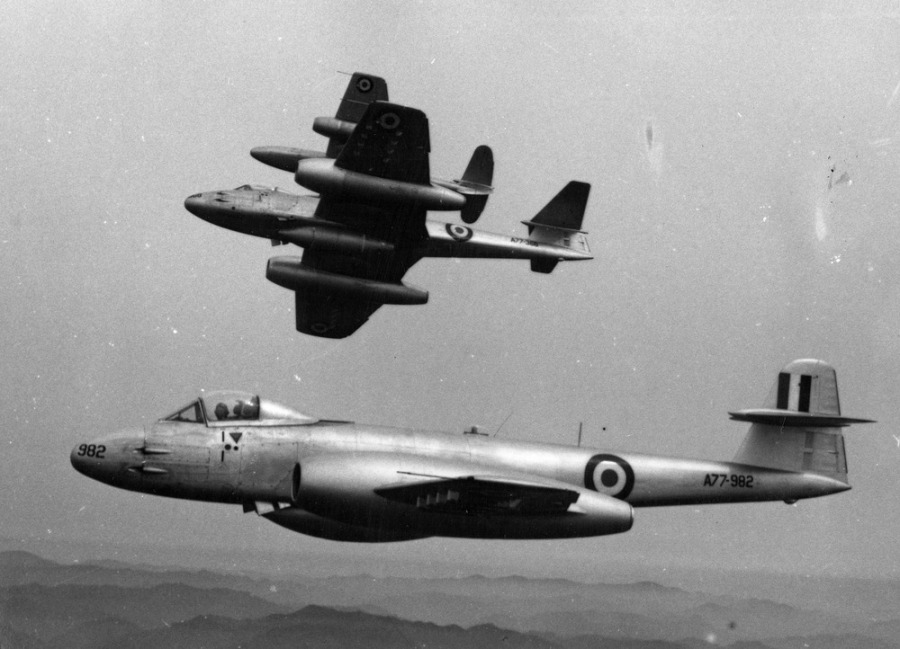

By 1958 the Gloster Meteor had been replaced in front line squadrons by the more advanced CAC Sabre but they did continue to serve with CAF squadrons until the aircraft was officially retired in 1963. Other Meteors continued to operate in a testing capacity with RAAF No. 1 Air Trials Unit and for Ministry of Supply trials at Edinburgh and Woomera Rocket Range in South Australia until the late 1960’s and 15 ex-RAAF F.Mk.8s were converted to be U.Mk.21 unmanned drones for missile testing in Woomera (most of the drones were subsequently destroyed by missiles).



RAAF ROUNDEL CHANGES 1956
On July 2nd, 1956 the red, white and blue roundel that had been used on Australian Flying Corps to RAAF aircraft since World War One (except for the period of 1942 to 1945 when the red dot was dropped to avoid confusion with Japanese aircraft) was changed to the famous Kangaroo in motion roundel (there was also a brief dalliance with a standing Kangaroo design). This in motion roundel is what remains on all RAAF aircraft today and the kangaroo always faces towards the front of any aircraft or vehicle it is applied to.
THE MALAYAN EMERGENCY 1948-1960
The Malayan Emergency (1948-1960) was declared on June 18th, 1948 following the murder of three estate managers by Malayan Communist Party (MCP) guerrilla fighters. The MCP was made up of disenchanted Malayan Chinese who disagreed with British citizenship policy and rule.
The MCP stepped up attacks on tin mining operations, rubber plantations and the like in Malaya. In 1950 the RAAF had become involved in offensive operations by Commonwealth forces against the Communist insurgents. RAAF No. 38 Squadron flying Douglas C-47 Dakota transport aircraft was deployed first and they were soon involved in supply drops to the troops and police fighting the insurgents in the jungle. The Dakota’s were also used to deploy paratroopers and drop propaganda leaflets to the insurgents below. The conflict escalated with the assassination of the British High Commissioner in October 1951. Half of No. 38 Squadron was deployed to Korea in November 1950 and then all returned to Australia in December 1952.

They transport aircraft were soon joined by No. 1 Squadron on July 17th, 1950 flying initially 6, then 8 Avro/GAF Lincoln bombers out of Singapore. The Lincoln’s went on to fly over 3,000 sorties from 1950-1958 bombing and strafing communist targets deep in the Malayan jungle (they dropped 14,000 tonnes of bombs during that period) with the aim of destroying them or driving them out of the jungle into Commonwealth controlled territory where they could be dealt with by ground forces. The Lincoln carried a good bomb load (6,350 kg / 14,000 lb) and plenty of guns (twin 0.50 caliber machine guns in the nose and tail turrets along with twin 20mm cannons in the dorsal turret) so it was well suited to the role. Only two Lincoln’s were lost during the emergency, both to accidents rather than enemy fire.
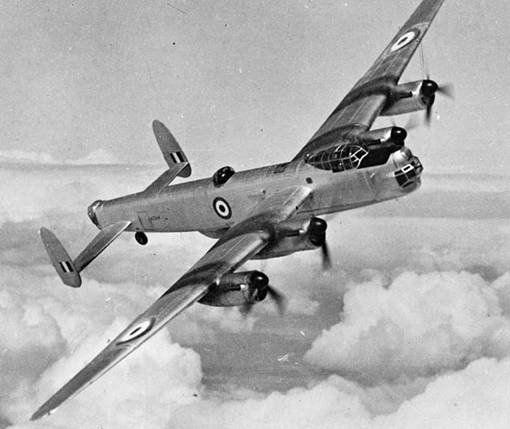


The RAAF operated 73 Avro/GAF Mk.30 and Mk.31 Lincolns bombers from 1946 to 1961. The first 5 were constructed from British parts and the rest were constructed in Australia and became the largest military aircraft to ever be manufactured in Australia. Only 11 were lost during that time and all due to accidents.
Apart from being used as a bomber, the Avro/GAF Lincoln also served in a number of other roles outside the Malayan field of operations in the RAAF, including 2 that were converted to VIP transports, 14 that were converted to long-range navigation (LRN) aircraft for special duties in 1949 and 20 that were modified to “Long Nose Lincoln” standard (they became GAF Lincoln MR31) with a 6′ 6″ nose extension to house a radar and it’s operators for maritime reconnaissance duties with No. 10 Squadron in Townsville, Queensland for patrols around northern Australia and the Pacific Ocean (only 10 were fully equipped for this role though). No. 11 Squadron based in Western Australia also used Lincoln’s for maritime patrol over the Indian Ocean. One of the Lincolns was used for surveying the Woomera Rocket Range and for flights over the Antarctic. Another conducted cosmic ray recording for scientific purposes and a further Lincoln was used in experimental rain making trials.

The maritime reconnaissance Lincolns were the last to be retired (replaced by the Lockheed P2V Neptune maritime patrol aircraft) and this ended the era of multi-engine heavy bombers in the RAAF. Sadly all Australian Lincoln airframes were scrapped or used for firefighting practice following their retirement. As such no complete example of a Lincoln is currently on display in Australia. A disassembled British airframe has been obtained by the Australian National Aviation Museum in Moorabbin, Victoria with the hopes of restoring it to the Australian variant of the Lincoln (this is a long-term project). It would be great to see an important part of RAAF history on display some day.

The Malayan Emergency was not declared over with the defeat of the MCP until July 31st, 1960 but in July 1958 No. 1 Squadron returned with their Lincoln’s to Australia to re-equip with jet powered Canberra bombers. The English Electric Canberra B.2 bomber was selected to replace the Avro Lincoln with an order of 48 aircraft in 1950.
Although the Canberra had a smaller weapons payload than the Lincoln it could deliver ordnance more accurately at lower levels and higher speeds, which was highly important to compete in a modern theatre of combat with more sophisticated air defences. The Canberra carried a 3,628 kg / 8,000 lb payload in an internal weapons bay and on two external underwing hard points which was 2,700 kg / 6,000 lbs less than the Lincoln.
The Government Aircraft Factory (GAF) built the Canberra bomber in Australia under licence with modifications including a reduction in crew from three to two (pilot and navigator/bombardier) and increased fuel capacity. The first came off the production line in 1953 and the last in 1958, they became known as the GAF Canberra Mk.20 (they were joined in 1956 by two British-built Canberra T.4 trainers and in 1957-1958 five Mk.20’s were converted to dual control Mk.21 trainers). In addition to No. 1 Squadron receiving the Canberra in 1958 they had also been operated by No. 2 Squadron since 1953 and No. 6 Squadron since 1955. The Canberra went on to serve with distinction for many years and the last was retired from the RAAF in 1982.

In August 1958 No. 2 Squadron took over the combat role and began operations in Malaya flying the GAF Canberra Mk.20 bomber (they had been operating them since 1953) out of the newly transferred RAAF Butterworth airbase in Malaya that had been extended to allow for jet operations (it was formerly an RAF base until 1957 and this would start a long RAAF involvement at Butterworth in defending Commonwealth nations within the region, with permanent aircraft based there from 1958 to the mid 1980’s. Even today Australian Defence forces deploy to the now Malaysian Air Force base to assist with training and defence treaty participation).
No. 2 Squadron arrived in Malaya at a time when the communist insurgency was more or less over but they still carried out a limited number of sorties including the first jet bomber combat sortie in the history of the RAAF in September 1958 when they attacked communist guerillas in Northern Malaya. Several strikes were also conducted against large communist camps in October 1958 with devastating effect. The squadron conducted their last combat sortie in Malaya on August 17th, 1959 when four Canberra’s attacked a communist target on the northern slopes of Bukit Tapah in Perak.


In February 1959 CAC Sabre jet fighters of No. 3 and 77 Squadrons joined the Canberra bombers at Butterworth. The air war was almost over by 1959 though and the Sabre was only used for occasional air strikes on communist targets in the Malayan jungle until the end of the conflict in 1960. Although the conflict was over, there was so much tension in South East Asia at that time the Sabre fighters of No. 77 Squadron were retained at Butterworth until 1969 (No. 3 Squadron returned to Australia in 1967).
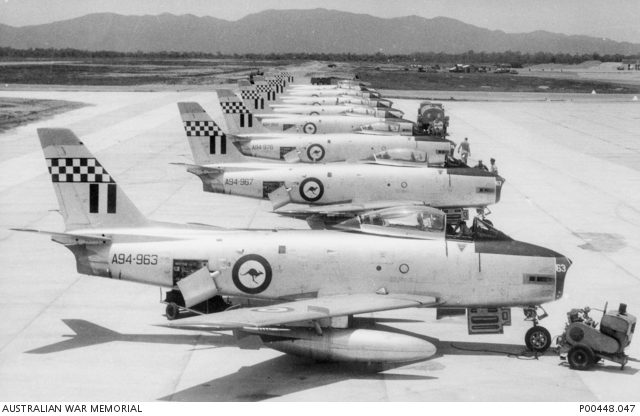
The CAC CA-27 Sabre was a Commonwealth Aircraft Corporation licenced built variant of the North American F-86 Sabre but had a redesign of 60% of the airframe to incorporate a more powerful 7,500 lb thrust Rolls Royce Avon turbojet engine (instead of the 6,100 lb thrust General Electric J47 turbojet), two 30mm Aden cannons instead of the standard six 0.50 caliber machine guns (the Sabre could also carry rockets, bombs and from 1960 Sidewinder air to air missiles), a larger air intake and increased fuel capacity. The Avon-Sabre is said to have been the best of the Sabre variants built around the world (Canadair could also lay claim to this).
The prototype CAC Sabre flew on August 3rd, 1953 and the first production Avon-Sabre flew on July 13th, 1954. 1 prototype and 111 production models were built with the last entering service on December 19th, 1961. They soldiered on in the RAAF until replaced by the Dassault Mirage IIIO (starting in 1964-1965) with the last retired on July 31st, 1971. The Sabre was operated by No. 3, 75, 76 and 77 Squadrons along with No. 2 (Fighter) Operational Training Unit at RAAF Williamtown.



In the 1960’s the CAC Sabre was also used by the RAAF Black Diamonds (1961 to 1964) and Marksmen (1966 to 1967) aerobatic demonstration teams. The Black Diamonds were from No. 75 Squadron flying 4 Sabre jets and the Marksmen flying 5 Sabre jets were from the No. 2 (Fighter) Operational Training Unit.


THE NEPTUNE ENTERS SERVICE
As previously mentioned the Lockheed P2V Neptune aircraft was selected by the RAAF to replace the Avro Lincoln in the maritime patrol role (they were purpose-built for this role and far more capable for anti-submarine warfare). The first 12 P2V-5 models (later re-designated P-2E) began to enter service in November 1951 with No. 11 Squadron in Western Australia. This initial batch of aircraft went through many modifications during their years of service.
The original Mk.1 variant had nose guns with a dorsal and tail gun turret; Mk.2 only retained the dorsal turret and had a glass nose and Magnetic Anomaly Detector (MAD) tail boom installed to assist in submarine detection; Mk.3 had the dorsal turret removed and the final Mk.4 version had 2 Westinghouse J34 under-wing turbojets fitted to increase speed to 586 km/h (364 mph) when required (with the Piston engines only, the top speed was 419 km/h / 260 mph). For anti-shipping and anti-submarine warfare the Neptune could carry bombs, depth charges, sea mines, torpedoes and rockets (3269 kg / 8000 lb ordnance payload).

On February 20th, 1957 three No. 11 Squadron Neptune aircraft set off for the Ghana independence celebrations (formerly the British colony Gold Coast) held on March 6th, 1957. They flew to the west coast of Africa via Asia (Minister for Air, Frederick Osborne joined the flight in Pakistan to act as Australia’s representative at the independence celebrations) and the crews remained in Ghana for 8 days. It was decided to extend the journey into Operation Westbound the first round the world flight by the RAAF as a test of the capabilities of the Neptune and the aircrews.
They left Ghana and set across the Atlantic Ocean to the United States (including a stopover at the Lockheed factory), then on to Fiji before returning to Australia and landing at RAAF Richmond in New South Wales on April 4th, 1957. The journey was originally intended to be completed in just 4 weeks but an engine unexpectedly needed to be replaced in the Azores in the Atlantic so the return flight was delayed.

Between March and May 1962 the maritime patrol fleet was increased when 12 SP-2H Neptune were delivered to replace the retired Lincoln’s of No. 10 Squadron in Townsville, Queensland. RAAF Neptune’s were used operationally during a number of South East Asian conflicts using its sophisticated radar and electronic counter measures to detect aircraft, surface to air missiles and to monitor radar transmissions.



No. 11 Squadron relocated to RAAF Edinburgh in South Australia in 1968 and from January 1969 the early model P-2E aircraft were replaced with 10 new Lockheed P-3B Orion maritime patrol aircraft. No. 10 Squadron relocated to RAAF Edinburgh in 1978 and upgraded to the P-3C Orion that same year.

THAILAND COMMUNIST INSURGENCY 1962-1968
In a little known part of RAAF history, on June 1st, 1962 eight CAC Sabres were deployed from RAAF Butterworth to Ubon Air Base, Thailand to help the Thai government counter communist activity that was feared may overspill their border from neighbouring Laos (along with forces from the United States, United Kingdom and New Zealand). This was part of Australia’s commitment to the Southeast Asia Treaty Organization (SEATO) and No. 79 Squadron was reformed using aircraft, pilots and ground crew from No. 77 Squadron for this purpose and remained active until withdrawn from Thailand in August 1968 (the squadron had originally been disbanded at the end of World War Two).

No. 79 Squadron acted as part of an integrated air defence system to protect Thai air space and from 1965 to also protect Thailand based USAF bombers and strike aircraft returning from sorties over Vietnam (ultimately no air attacks ever occurred against Thailand though). The Sabre jets were also used in training exercises with the USAF to simulate attacks by the similar North Vietnamese MiG-17 Fresco aircraft.
In December 1965 a request was made from the United States for the squadron to participate in attacks on the Ho Chi Minh Trail. This would have required an expansion of scope in Thailand and given the RAAF was then also deployed in South Vietnam, Malaysia, Singapore and back home this would have stretched resources too far. The request was rejected by the Australian Government in March 1966

By 1968 the USAF had a sufficient fighter force in Thailand and the RAAF Sabre jets were then considered obsolete. The jets were withdrawn and the squadron was disbanded at the end of July 1968. During their deployment two CAC Sabre jets were lost due to engine failure whilst in flight (the first on September 24th, 1964 pilot Flight Lieutenant Ian McFarlane ejected safely. The second on January 3rd, 1968 sadly resulted in the loss of Pilot Officer Mark McGrath).
INDONESIAN CONFRONTATION 1963-1966
Malaya gained independence from Great Britain in 1957 and the new Federation of Malaysia was formed in September 1963. Malaysia and Britain wanted North Borneo to be part of this federation but Indonesia’s President Sukarno was not too keen on this and wanted it to be part of Indonesia (North Borneo bordered on their province of Borneo and they had also just incorporated West New Guinea into Indonesian territory). As such fighting broke out and between 1963 to 1966 an undeclared state of war existed between Malaysia and Indonesia which became known as the Indonesian Confrontation. The small-scale fighting also involved Commonwealth forces from Great Britain, Australia and New Zealand. The wheels for conflict were set into motion as early as December 1962 when an Indonesian backed coup (they trained and presumably equipped those involved) attempted to take over the small sultanate of Brunei on North Borneo. British and Gurkha forces quashed the coup but it was just the beginning as supporters of coup leader Sheikh A.M. Azahari continued to conduct incursions into North Borneo and were soon joined by Indonesian soldiers conducting sabotage missions.

These incursions into North Borneo continued throughout 1963 and into 1964. The war escalated during two Indonesian paratroop and amphibious landing raids on the Malaysian south-west peninsula (Labis and Pontian) in September and October 1964. Commonwealth forces including the Australian Army repelled these attacks. By 1964 Commonwealth forces had set up strong points along the border and had begun their own offensive cross-border incursions into Indonesia. Indonesian forces began to take a more defensive stance and incursions and attacks from their side of the border were reduced. Fighting with Indonesian troops continued throughout 1965 and 1966 including a number of larger engagements.

During this conflict the RAAF was not involved directly in combat but did provide transport and air defence for Commonwealth forces mainly from the Butterworth air base in Malaysia. RAAF Douglas C-47 Dakota attached to No. 2 Squadron and Lockheed C-130A Hercules (from Darwin) aircraft along with a small number of Bell UH-1B Iroquois helicopters of No. 5 Squadron (first deployed 4 helicopters in 1964) transported troops, equipment and supplies during the conflict. RAAF CAC Sabre fighters of No. 3 and 77 Squadrons armed with Sidewinder air to air missiles and GAF Canberra bombers of No. 2 Squadron were kept on ready alert for air defence and strike duties if required (fighters were scrambled from time to time to intercept Indonesian aircraft but these were uneventful sorties). In addition the RAAF monitored Indonesian radar transmissions using electronic counter-measures (ECM) equipment fitted to Lockheed P-2 Neptune aircraft.


The Indonesian Confrontation ended when a peace treaty was finally signed by Malaysia and Indonesia in August 1966. North Borneo remained as part of Malaysia. Due to the sensitive nature of the confrontation little was made public at the time. 23 Australians died during the conflict and a further 8 were wounded. RAAF aircraft remained at Butterworth following the conflict though as tensions in South East Asia continued. Interestingly despite the earlier conflict the Australian government donated CAC Sabre aircraft to both the Malaysian and Indonesian air forces between 1969 and 1972!
THE RAAF ENTERS THE SUPERSONIC AGE
Planning for a fighter to replace the CAC Sabre began in the 1950’s. Finally in 1960 the Dassault Mirage IIIO was selected over the Lockheed F-104 Starfighter and brought the RAAF into the supersonic age as the delta winged Mirage III was Mach 2.2 capable (the F-104 was more limited in being primarily an interceptor and despite being used by other nations in the role, was not as well suited to ground attack).The first Mirage IIIO was delivered for testing to the RAAF on April 9th, 1963 (in France). 2 Mirages were then shipped to Australia where the first flight took place on November 16th, 1963. Production soon began in Australia at the Government Aircraft Factory (GAF) and the first of 48 Australian built Mirage IIIO(F) single seat interceptors were delivered in 1964 to No. 2 Operational Conversion Unit (2OCU) at RAAF Williamtown and in 1965 No. 75 Squadron became the first operational unit, with No. 76 Squadron receiving aircraft in 1966.

The next Australian produced batch was 50 Mirage IIIO(A) ground attack fighters equipped with a different radar and equipment for low-level operations. These aircraft joined No. 3 Squadron in 1967 and No. 77 Squadron in 1969. To increase commonality of the fleet, in June 1969 the Mirage IIIO(F) aircraft were modified to the ground attack standard. The first of 10 Mirage IIID twin-seat trainers (without radar) were delivered to the RAAF on November 10th, 1966 with the remainder delivered in 1967. In 1970 a further 6 Mirage IIID trainers were ordered for a total of 116 Mirage IIIO/D airframes.


Mirage IIIO/D aircraft were also operated by the RAAF Aircraft Research and Development Unit (ARDU) which is tasked with the testing and evaluation of RAAF aircraft and weaponry. Originally formed in 1943 as the No. 1 Air Performance Unit and based at RAAF Laverton in Victoria, the unit was renamed to ARDU in 1947 and also had detachments in New South Wales and South Australia. Since 1977 they have operated from RAAF Edinburgh in South Australia.

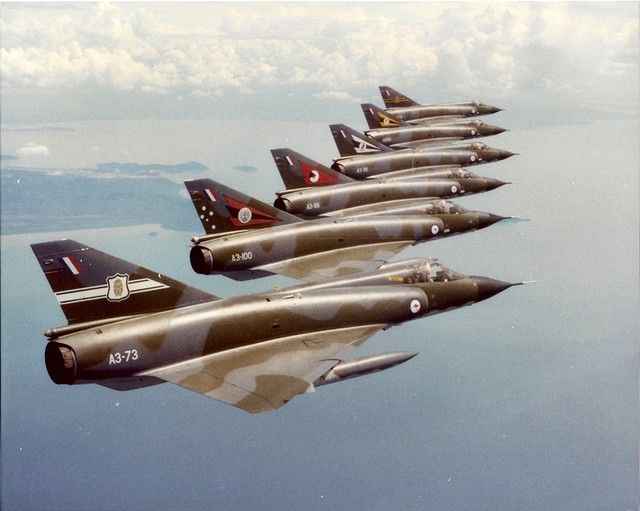
The Mirage IIIO was well armed in either the air or ground attack role. For fighter duties in addition to the twin 30mm DEFA cannons the Mirage could be armed with 1x Matra R530 medium range radar guided missile and either 2 x Sidewinder AIM-9B or 2 x Matra R550 Magic short-range air-to-air missiles. For ground attack missions 6 x Mk.82 227 kg / 500 lb bombs or three GBU-12 laser-guided bombs could be carried.


In 1967 No. 75 Squadron deployed with the Mirage IIIO(F) to RAAF Butterworth in Malaysia allowing No. 3 Squadron to return to Australia and re-equip with the Mirage IIIO(A). Defence cuts in 1973 saw No. 76 Squadron disbanded and in 1983 No. 75 Squadron relocated from RAAF Butterworth to Darwin to provide air defence for Australia’s north. The Mirage IIIO was not deployed for use during the Vietnam War and never saw combat with the RAAF. Despite losing over 40 aircraft in accidents it served the nation well for over 20 years (a high number but from what I have read this seems comparable to other operators of 1960’s era jets such as the Lockheed F-104 Starfighter that was unfairly dubbed by the media as a “widow maker”).


Between 1986 to 1988 the Mirage IIIO was replaced by the far more capable McDonnell Douglas F/A-18 Hornet and No. 75 Squadron became the first and last operational Mirage squadron. The last RAAF Mirage flight was on February 8th, 1989 when an ARDU Mirage IIIO flew to storage in Woomera, South Australia. 50 of the surviving Mirage IIIO/D airframes were sold and shipped to Pakistan in November 1990 for refurbishment to supplement their existing fleet of Mirage III aircraft (operated since 1968). The remaining aircraft went to various museums and airbases around Australia for display and airframe training purposes.
In the mid 1980’s I was lucky enough to see an ARDU Mirage IIID and a brand new F/A-18A Hornet do a demonstration flight to show why the Mirage was being replaced, the modern F/A-18 was able to circle around twice whilst the less manoeuvrable Mirage III made one circling turn (the changing of the guard was well needed)!

ADVANCED JET TRAINING
To facilitate training of pilots in high-speed combat aircraft the RAAF determined the aging trainer fleet of de Havilland Vampire jets along with the CAC Winjeel needed to be replaced with a modern advanced jet trainer. 110 Vampire trainers were operated by the RAAF with the first delivered in 1952 and phased out of service between 1968 and 1970. The Winjeel, an Australian built and designed basic trainer entered service in 1955 with No. 1 Flying Training School at Point Cook and 62 were produced. They were also used to train RAAF flight instructors at the Central Flying School at East Sale. Retired from the training role in 1975, a small number of Winjeel aircraft soldiered on as Forward Air Control aircraft until 1995.
The Italian designed Aermacchi MB.326H jet trainer was selected as a replacement for the RAAF in August 1965 and 97 were procured. 10 were operated by the Royal Australian Navy from 1970 to 1983 when they were transferred to the RAAF.



The first Aermacchi MB.326H was manufactured in Italy and delivered to the RAAF on October 2nd, 1967. The Commonwealth Aircraft Corporation (CAC) and Hawker de Havilland built the rest of the airframes under licence in Australia with the last being delivered in September 1972 (the first 20 aircraft were built from Italian manufactured components but by the 31st airframe 85% of the components were manufactured in Australia including the Rolls Royce Viper turbojet engine). The initial RAAF plan was to have all jet training but after just two courses this was soon determined to be unsuitable and propeller driven aircraft trainers were continued (the Winjeel remained in service as a basic trainer until 1975 and in the Forward Air Control training role until 1994), then you would advance to the jets. The MB.326H was known as the Macchi Jet in Australia and remained in service until 2001 (replaced by the BAE Hawk).

The Macchi was operated mainly by No. 2 Flying Training School (2FTS) at RAAF Base Pearce in Western Australia from 1970 until the final advanced pilot training course was held in the Macchi in 1991. The Central Flying School (CFS) at RAAF East Sale operated the Macchi for flying instructor training. No. 2 Operational Conversion Unit (2OCU), No. 5 Operational Training Unit (2OTU) and No. 25, 76, 77 and 79 Squadrons used the Macchi in the lead-in fighter role to emulate fighter aircraft in pilot training scenarios (significantly cheaper than using operational combat aircraft).
From 1989 advanced pilot training was taken on by the then new Pilatus PC-9 turbo-prop trainer and the lead-in fighter trainer role was the last for the Macchi jet prior to its 2000/2001 retirement. One of my fond memories from the 1980’s was helping aircrews push Macchi jets on the ground and getting to sit on the cockpit afterwards during a training mission to my country towns airfield in Horsham, Victoria.

The Macchi jet became a beloved aircraft for many Australians as it was also used by the RAAF Roulettes demonstration team around the country. The Roulettes were formed in 1970 with flying instructor pilots from RAAF Central Flying School (CFS) based at RAAF East Sale in Victoria flying the MB.326H (at first four were used, this was increased to five in 1974, seven in 1981 and with budget constraints back to five in 1982). They operated the Macchi until the late 1980’s when metal fatigue issues started to plague the RAAF fleet.
They were replaced in the team in late 1989 by the more economical turbo-prop Pilatus PC-9 advanced trainer (they continue to fly six PC-9’s with a spare performing all over Australia). 3 Roulette Macchi jets were lost in two separate mid-air collisions in 1983 and 1988, sadly resulting in the death of 2 pilots in the 1983 incident. A pilot ejected safely and another Macchi landed safely with gears up in the 1988 collision. These incidents all made national news at the time.

THE VIETNAM WAR 1962-1972
The 1960’s began the RAAF’s longest battle against Communist forces when the Vietnam War commenced. Initially Australian Army training advisors were sent to aid the South Vietnamese government in 1962 but the war soon escalated and all services of the Australian Defence Forces were involved in what would become Australia’s longest war with combat forces deployed in action from 1962 to 1972 against North Vietnamese and Viet Cong forces (the war finally ended with the capitulation of South Vietnam in 1975). 50,000 Australian Defence Force personnel (4,443 RAAF) were involved in the war of which 496 died and over 2,398 were wounded (Australian Bureau of Statics figures). The withdrawal of the Australian Defence Forces from Vietnam followed much political and social unrest back at home. It had become an unpopular fight that had to end. Highlighting the contribution of the RAAF in Vietnam, over 300 bravery awards were presented to RAAF personnel during their service there.
Combat Aircraft
No. 2 Squadron based at RAAF Butterworth in Malaysia since 1958 was deployed on April 16th, 1967 with their GAF Canberra Mk.20 bombers to Phan Rang, South Vietnam. The squadron operated as part of USAF 35th Tactical Fighter Wing alongside USAF Martin B-57 Canberra bombers.

No. 2 Squadron was tasked with up to 8 sorties a day and would go on to conduct almost 12,000 highly effective operational sorties including low-level tactical day and night strike bombing missions (mostly night missions a typical weapons payload was 6 x 455 kg / 1000 lb bombs) dropping 76,389 bombs against communist forces until June 4th, 1971 when they returned to Australia ending 13 long years of overseas deployment (first operated out of Malaya in 1958). The Canberra was highly effective because it could operate in all-weather, deliver ordnance with high accuracy at low-level (“Skyspot” radar directed and visual bombing missions) and could stay on station awaiting targets of opportunity for long durations (3 to 4 hours).



Despite flying only 6% of the USAF 35th Tactical Fighter Wings sorties, No. 2 Squadron inflicted 16% of the collective damage and they were awarded a Republic of Vietnam Cross of Gallantry and a United States Air Force Outstanding Unit Commendation for their gallant efforts. These awards along with a United States Presidential Unit Citation presented in World War Two (the highest honour awarded to a combat unit by the United States government) make it the most highly decorated squadron in the history of the RAAF.


From 1967 to 1971 despite hostile ground fire and plenty of damage inflicted upon their aircraft (the Canberra was one tough bird), No. 2 Squadron only lost 2 aircraft during the conflict and amazingly none were lost until into their 4th year of deployment in Vietnam. The first Canberra (number A84-231) was lost without trace in November 3rd, 1970 whilst on a bombing mission in a remote area near the Laos border. The two-man crew of pilot Flying Officer Michael Herbert (198 missions in Vietnam since February 1970) and navigator Pilot Officer Robert Carver (who had only been in Vietnam for less than 2 months) radioed at 8:22pm that they had dropped their bombs on target but by 10:15pm radio contact was lost. It was presumed they were hit by enemy ground fire or a Surface to Air Missile and a search crew failed to locate them. Herbert and Carver both 24 years of age were declared Missing In Action (MIA) and presumed lost forever. These brave airmen became the last missing Australian military personnel in Vietnam (all others had been found or accounted for over the years since the 1972 withdrawal from Vietnam).



In 1984 the Australian Government sent delegates to Vietnam to renew the search to discover the crews fate but were unsuccessful. In October 2008 the Chief of the Australian Air Force asked the Army History Unit to conduct an investigation into the aircrafts disappearance. Then in April 2009 under Operation Magpies Return (the emblem for Number 2 Squadron is a Magpie) a search team located the wreckage in the remote and rugged Quang Nam Province! An RAAF team went to the site in July 2009 to locate the remains of the airmen which were subsequently recovered and positively identified by forensic experts in Hanoi (the RAAF was assisted by the Vietnamese government along with information from former North Vietnamese Army and Viet Cong personnel and local villagers to locate the wreckage). Thankfully for their families they had been found and could finally be returned home.


The second Canberra lost by No. 2 Squadron (A84-228) set out on a sortie on March 14th, 1971 near Quang Tri in South Vietnam. It was struck by a Surface to Air Missile (SAM). Both pilot Wing Commander F.J.L. Downing and navigator Flight Lieutenant A.J. Pinches were able to eject and evade capture for 27 hours until a US Army helicopter was able to rescue them. Both suffered injuries in the incident but made it home relatively safe and sound from their harrowing ordeal.
During the Vietnam War RAAF No. 10 Squadron Lockheed P-2 Neptune aircraft based out of U-Tapao airbase in Thailand were used to detect airborne targets such as surface to air missiles with the aircrafts powerful AN/APS-120 radar. These missions were conducted to support USAF Boeing B-52 Stratofortress bombers operating out of the same base whilst they were flying in Thai airspace.

Non flying RAAF personnel based in Vietnam during the war included ground crews, Air Defence Guards who were responsible for security at RAAF bases in Vung Tau and Phan Rang and personnel from No. 5 Airfield Construction Squadron who had worked on developing the bases between 1966 to 1968. In addition 36 RAAF fighter pilots were assigned to the USAF between 1966 to 1971 to fly Forward Air Control (FAC) aircraft like the Cessna O-1 Bird Dog, Cessna O-2 and Rockwell OV-10 Bronco.
The FAC role was to fly low over enemy territory to spot and target the enemy with marker rockets for air strikes from combat aircraft that would be circling high above (including USAF, USMC, US Navy, RAAF and South Vietnamese aircraft). They would also call in artillery strikes. The FAC aircraft would stay nearby to report on the success of air/artillery strikes and call in more if necessary. This was dangerous work as these light FAC aircraft were very susceptible to enemy ground fire. 15 of these RAAF pilots were awarded a DFC and 2 a DSO for their efforts in such a dangerous environment.

Helicopter Operations
RAAF helicopter operations commenced in South Vietnam on June 6th, 1966 with the deployment of No. 9 Squadron and 8 Bell UH-1B Iroquois helicopters to the Vung Tau airbase and Nui Dat (the UH-1B were first operated by the RAAF in 1962 for Search And Rescue duties). The initial deployment of UH-1B helicopters were limited as they could only carry 5 troops onboard. This was improved in 1967 when larger UH-1D models were introduced (they could carry an additional 4 troops onboard) and by 1968 the deployment was increased to 16 helicopters when the improved UH-1H was introduced and replaced the B/D models which were returned to Australia (RNZAF and Royal Australian Navy pilots also joined the squadron in 1968). The RAAF could now carry larger loads over longer distances which was a great assistance to the Australian Army and the 1st Australian Task Force (1ATF) involved in the fight against communist forces on the ground.


RAAF helicopters in Vietnam conducted troop landings (including the insertion of the Special Air Service on special operations), supply drops, medical evacuations (4,300 were conducted by the squadron from 1966 to 1971!), spraying defoliant chemicals, dropping propaganda leaflets and reconnaissance missions. In 1969 four of the UH-1’s were converted to “Bushranger” gunships armed with twin-fixed forward-firing 7.62-millimetre mini-guns, two seven-tube 2.75″ rocket launchers and two 7.62 mm M60 machine-guns mounted in the doors to provide fire support during operations. The UH-1’s took plenty of enemy ground fire an a number were shot down or badly damaged in combat.

No. 5 Squadron was the other helicopter unit in the RAAF during this period but they remained in Australia for peacetime operations including air crew training and Search And Rescue (SAR). The training role was essential to rotate crews through frontline operations in South Vietnam. RAAF helicopter operations continued in Vietnam until November 19th, 1971 continuously supporting 1ATF operations, amassing an incredible 237,424 missions (sadly six members of Number 9 Squadron became fatalities and six helicopters were lost during their deployment)! The helicopters were then flown onto the deck of the transport aircraft carrier HMAS Sydney and returned to Australia.
One of the most renown missions flown by RAAF UH-1 crews in Vietnam was during the overnight Battle of Long Tan on August 18th, 1966 where 108 Australian soldiers of D Company 6RAR came under heavy attack in a rubber plantation near their base of Nui Dat and with support from Australian / New Zealand and US artillery and Australian Armoured Personnel Carriers defeated a far larger force of Viet Cong (estimated at up to 2,500 enemy fighters with possible assistance from the North Vietnamese Army. 245 were confirmed killed with evidence others had been removed from the battlefield. 18 Australians were killed with a further 24 wounded). During the battle at 6pm 2 of the RAAF helicopters flew in at tree top height in bad weather and under enemy fire to resupply the troops with sorely required ammunition and at 10:45pm 7 of the helicopters were able to operate in the dark with no lights (at the request of the Army commander to not highlight where the Australians were – remember this was before effective night vision goggles) to land and evacuate the wounded without loss.

Transports
The RAAF deployed 7 de Havilland Canada DHC-4 Caribou battlefield tactical transports and 100 personnel to Vietnam with RAAF Transport Flight Vietnam and No. 35 Squadron to Vung Tau between August 8th,1964 and February 26th, 1972 (18 aircraft were delivered to the RAAF from February 25th, 1964. A further 7 were delivered in 1966 to replace one lost in an accident and to cover those operating in Vietnam. 4 more were delivered between 1968 to 1971). A flight from No. 38 Squadron was also deployed with 3 Caribou transports to Port Moresby, Papua New Guinea between 1965 to 1975 to support the PNG Defence Force (PNG gained independence from Australian administration in 1975).


Vol. 30, December 2009)
The Vietnam Caribou detachment were affectionately known as “Wallaby Airlines” (their radio call sign was “Wallaby“) and conducted general transport duties along with dropping paratroops and Special Air Service (SAS) missions in a “hot” battlefield environment. They could carry anything from troops and battlefield medical evacuees to general supplies, the mail, Vietnamese family evacuees, livestock, equipment and even the occasional USO performing troop!
Two DHC-4 aircraft were allocated for support duties of the special forces based at Nha Trang and Da Nang. This was dangerous work after October 1964 as they often came under enemy ground fire near these bases and both aircrew and passengers suffered injuries.
Between late 1964 and January 1965 the DHC-4 aircraft were also used as night-time pathfinders. They would drop flares over target areas to illuminate them for USAF attack aircraft but this proved very dangerous work as the slow DHC-4 was vulnerable to enemy anti-aircraft guns. At the request of the RAAF this role was taken over by faster South Vietnamese Air Force Douglas DC-3 aircraft.
No. 35 Squadron flew at least 4 flights a day for anywhere up to 12 to 14 hours for each flight and would use at five of the six aircraft each day in Vietnam. Pilots were flying twice as many hours than they would in peacetime! They flew and landed (often on short strips) in all conditions including bad weather and dangerous terrain (from rugged mountains to swampy ground). The DHC-4 had fantastic slow and low flying characteristics and the crews developed the Low Altitude Parachute Deployment System for delivering cargo from just a few feet above ground where a landing was not possible or practical. Ground crews worked hard (around the clock when required) and would even pick off parts from damaged US aircraft and scrap piles to find spare parts to keep these aircraft flying.

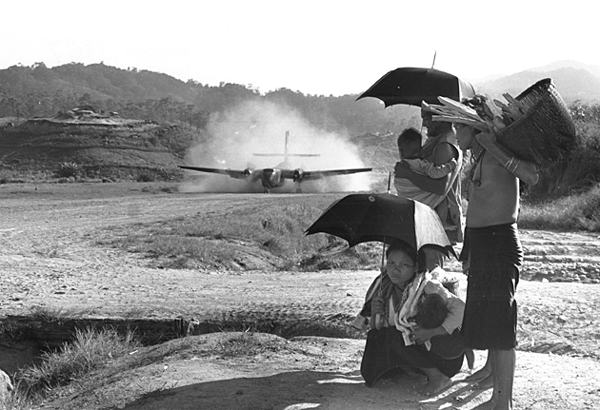
The first three military awards presented to RAAF personnel in Vietnam were to No. 35 Squadron members in 1965 for courage displayed under fire. One on a flare dropping mission (pilot Flight Lieutenant Ronald Raymond), another for returning enemy fire on a mission (loadmaster Leading Aircraftman Daniel Gwin) and the last for aiding in the retrieval of a damaged aircraft under enemy fire in November 1964 (Corporal Robert Wark). In addition Squadron Leader Christopher Sugden received a bar to his DFC in December 1965 and Squadron Leader Stanley Clark (Commanding Officer November 1970 to November 1971) received a DFC in 1972.

Despite adverse conditions and the threat of enemy ground fire not one man was lost from the deployment and only three of the DHC-4 aircraft were destroyed in Vietnam (one from mortar fire whilst on the ground at That Son near Cambodia on March 29th, 1970). Two others were badly damaged and returned to Australia for major repairs. The flight was reduced to 4 aircraft in 1971 before the remainder returned to Australia in 1972. No. 35 Squadron ended up flying almost 80,000 sorties, clocking up 47,000 hours of flight time and carrying over 600,000 passengers along with 41,000 tonnes of freight and mail in seven and a half years of operation in Vietnam!

Heavy logistics support of equipment/supplies and troop transport to and from Vietnam, along with medical evacuations and the return of killed servicemen out of the region to Australia (via RAAF Butterworth in Malaysia) were conducted by Lockheed C-130 Hercules transports from RAAF Richmond in New South Wales from 1965 to 1972. Normally flights were conducted on a fortnightly basis unless operational circumstance required them more frequently. RAAF Nurses would be onboard medevac flights to aid patients and over 3,100 men were returned on these rough but ready flights equipped with stretcher litters in the cargo bay. The last Australian troops to leave Vietnam in 1972 flew out aboard a Hercules.

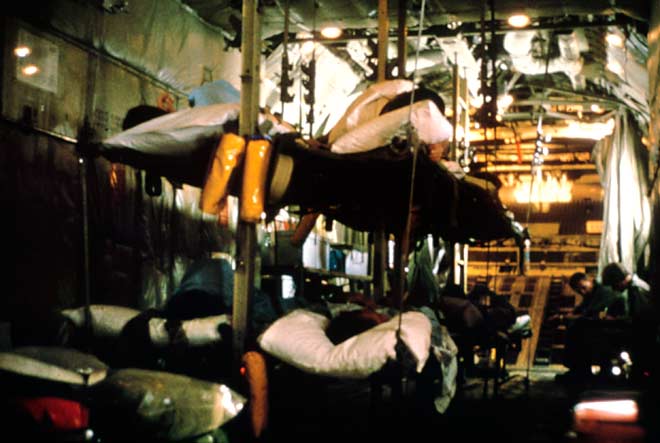
The Hercules had first been delivered to No. 36 Squadron between December 1958 and March 1950 with 12 C-130A models which replaced the Douglas C-47 Dakota. This order made Australia the first foreign operator of the Hercules. To cope with the increased transport requirements of the Vietnam War, an additional 12 C-130E model were delivered between August 1966 and January 1967 to the reformed No. 37 Squadron. The performance, payload and handling characteristics of the Hercules have been invaluable to the RAAF ever since.

PHABULOUS PHANTOMS
By the end of Australia’s involvement in the Vietnam War in 1972 the Canberra bombers were well and truly obsolete. Although most were already retired from RAAF service with No. 1 and 6 Squadrons relinquishing their aircraft by 1970, No. 2 Squadron soldiered on until 1982 with one of the last roles for this great jet being cartographic surveys of Australia and other countries including Indonesia (special cameras were fitted). The aircraft was officially retired on June 30th, 1982.
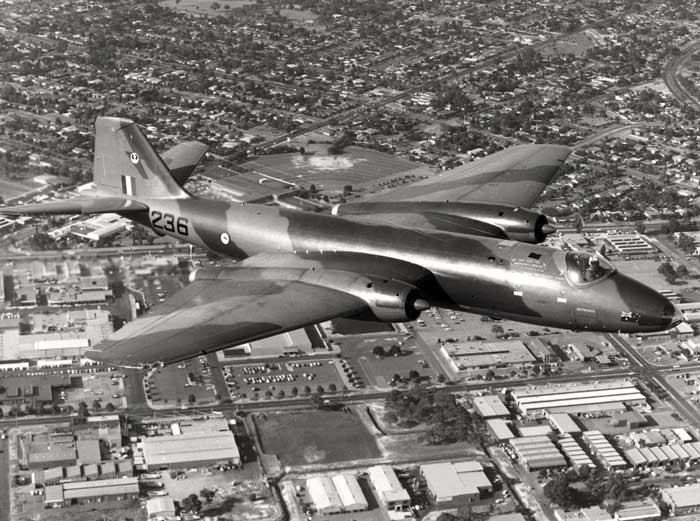
The Canberra was due to be replaced by the General Dynamics F-111C strike bomber but due to long development delays with this highly sophisticated aircraft (originally ordered in 1963!), No. 1 and 6 Squadrons operated 24 new McDonnell Douglas F-4E Phantom II fighter bombers that were leased from the USAF as a stop-gap combat aircraft to fill the operational void until the F-111C could be delivered. The F-4E was offered at a heavily discounted price and they were delivered to RAAF Amberley in September/October 1970.


The Phantom II was one of the most successful combat aircraft of its time and was used by many air forces around the world. It proved to be popular with RAAF ground and aircrews too and it was considered to cancel the F-111C order and purchase the Phantoms instead. This was going to be too expensive though, as tanker aircraft would also have been needed to make up for the range difference offered by the F-4E (such aircraft were not purchased until the 1980’s). As such the purchase of the F-111C went through and the rest is history – a successful one at that as the F-111 served for almost 40 years from 1973 to 2010!
23 of the 24 F-4E’s were returned to the United States in 1973. F-4E Serial number 69-7203, operated by No. 1 Squadron, was lost on June 16th, 1971 during a navigation exercise when it crashed into the sea near the Evans Head Bombing range in Queensland. Sadly both crew members died in the crash. 6 RAAF pilots also flew Phantoms during the Vietnam War whilst on exchange duty with the USAF (Flight Lieutenant Lindsay Naylor was awarded a DFC for an act of bravery during an F-4 strike mission in Vietnam near Pleiku in April 1971).
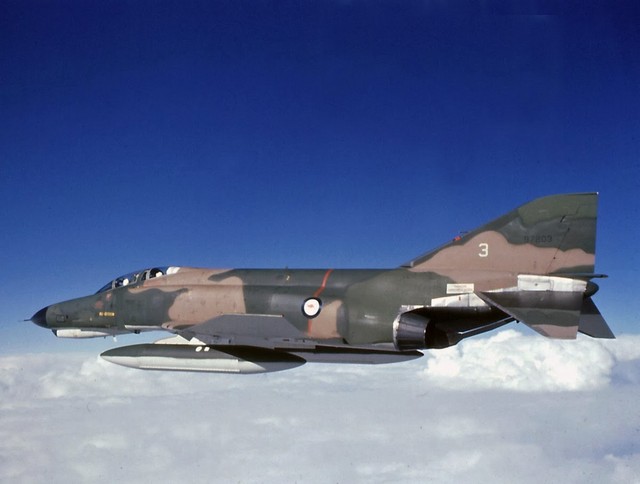

OTHER NOTABLE RAAF AIRCRAFT (1950 – 1972):
North American P-51D Mustang / CAC Mustang fighter aircraft (see The Cold War begins and the Korean War for more information).
BAE HS-748: Two VIP transports for No. 34 Squadron, operated 1967 to 1996. Eight navigation trainers for the School of Air Navigation, operated 1968 to 2004 (from 1989 they were operated by Number 32 Squadron).
BAE BAC-111: Two VIP transports for No. 34 Squadron, operated 1967 – 1989.
Dassault Mystere 20: Three VIP transports for No. 34 Squadron, operated 1967 – 1989.

Following two hectic decades of conflict, the RAAF entered the mid 1970’s with a more peaceful role. Next up we will take a look at the post Vietnam War RAAF involving Peacekeeping around the world and then a return to combat in the Middle East some 20 years later.
Resources:
Australian involvement in South-East Asian Conflicts
RAAF – Air Power Development Centre
Wikipedia


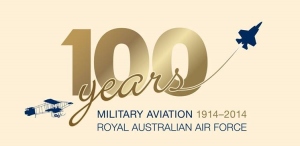
Well! This one’s saved for a quiet hour or two over the holidays. Nice work, Deano.
On the RAAF roundel – I’ve seen another version where the roo is standing up. The photo was taken at our South Pole base if I recall correctly.
LikeLike
Enjoy!
I have only seen things like this: http://www.clubhyper.com/reference/images/afc_kangaroo_markings_002.jpg
LikeLiked by 1 person
Here are a few photos of the other roundel used by the RAAF Antarctic Flight
http://forum.keypublishing.com/showthread.php?119197-WORLD-AIR-FORCE-ROUNDELS/page5
http://www.antarctica.gov.au/about-antarctica/history/transportation/aviation/1955-69
Fir an interesting read about the RAAF in Antarctica check out the book Alfresco Flight
LikeLiked by 2 people
I am glad they didn’t go with the upright roo! Cool to see these pics though. Thanks!
LikeLike
Reblogged this on The mind is an unexplored country. and commented:
All you old Biggles fans – get your history fix here!
LikeLiked by 1 person
[…] War Two – 1939 to 1945, The Cold War begins and the Korean War – 1945 to 1953, South East Asian Conflicts – 1950 to 1972, Peacekeeping and Modern Conflicts – 1973 to 2014 and finally The […]
LikeLike
[…] War Two – 1939 to 1945, The Cold War begins and the Korean War – 1945 to 1953, South East Asian Conflicts – 1950 to 1972, Peacekeeping and Modern Conflicts – 1973 to 2014 and now The Future […]
LikeLike
[…] World War Two – 1939 to 1945, The Cold War begins and the Korean War – 1945 to 1953, South East Asian Conflicts – 1950 to 1972, Peacekeeping and Modern Conflicts – 1973 to 2014 and finally The Future […]
LikeLike
[…] War Two – 1939 to 1945, the Cold War Begins and the Korean War – 1945 to 1953, South East Asian Conflicts – 1950 to 1972, Peacekeeping and Modern Conflicts – 1973 to 2014 and finally The […]
LikeLike
[…] years), World War Two: 1939 to 1945, the Cold War begins and the Korean War: 1945 to 1953, South East Asian Conflicts – 1950 to 1972, Peacekeeping and Modern Conflicts – 1973 to 2014 and finally The […]
LikeLike
Always cool finding websites like this. So many of my fathers photos on display yet credited to RAAF, War Memorial or some other source but great to see. Thanks
LikeLike
Hi Grant, thanks for the comment. Please let me know his name and applicable photos and I am more than happy to add it to the caption. I always try and credit where I locate them and the info provided from those sources but they rarely seem to mention who the photographer is.
LikeLike
Hi Deano, I was flying the DA20 in the last photo. I can give you more details if you wish. Also have done additional CFS pics if you wish. Cheers, Mark (Alf) Arman
LikeLiked by 1 person
Hi Mark, any info you would like to share would be great. Thanks!
LikeLike
Hi Mark, how many passes did you guys make to get the formation distance right with the Turbo (Or Draggie – depending on which base you were on)
LikeLike
Reblogged this on War Machine Museum.
LikeLike
[…] CAC F86 Sabres lined up in Malaya […]
LikeLike
Very interesting When 2squadron departed a new unit was formed called 1TSF I was the Equp Clerk and had to send the aircraft status reports which were Top Secret. . They left one canberra behind, and each week it was exchanged after a major D service.,Also this new unit had a couple of Dakotas used for secret missions into other areas, Canberra A84 232 was a surveillance aircraft now at Vietnam Vets museum on Phillip Island, Six months later we became defunct and part of 478 Maint Sqn Never knew this until discharge and read my postings, dont think anybody was to be made aware of this. Thank you for the photographs much enjoyed A316170 Don
LikeLiked by 1 person
Thanks Don. Always interesting to get the inside word, so to speak!
LikeLike
Best wishes on your excellent historic work. I noticed a name that requires editing – Mark McGrath (not Michael) who was killed in Thailand flying a CAC Sabre Jet. He was my cousin, Pilot Officer Mark McGrath who served with 77 Sqn and 79 Sqn in 1967-68 until his untimely accidental death in January 1968 at Ubon, aged 23 years. Thailand. We are always searching for information or photos of our departed Cousin and Uncle. I have photos available. Regards, Mike O’Reilly, Adelaide
LikeLiked by 1 person
Thanks for the information Mike. Sorry for the error. I will correct that.
LikeLike
Deano, The pic labelled as a large formation of Vampires in the 1950s was in fact, the formation flypast for the end of No 61 Pilots Course at 2FTS RAAF Pearce on 17 August 1967. The leader was the CFI, SQNLDR Tom Thorpe AFC. I flew No 27 as the herder, way down the back!!
LikeLiked by 1 person
Thanks Dave. I will add that description. It must have been some experience!
LikeLike
Deano, The caption under the Lincoln with a broken back indicating it was a structural failure on landing is not correct. I checked and old friend who was the squadron QFI at the time and he dispelled any myth about a bad landing. He said the hangar collapsed on it during a cyclone!
Dave Rogers
LikeLike
Interesting! I used info from the photo source on that one
LikeLike
Congrats on a very interesting article well worth the read.
As the then CO of 76 SQN, I was the pilot of Macchi 070 for the Photoshoot that you showed of the aircraft over the Stockton Beach. This flight was on 23 November 1992 and in the rear seat was LAC Mottram who designed the paint scheme to reflect the 25 years of Macchi ops in the RAAF. Another aircraft, 062, was painted in a similar scheme prior to 070 but on the day it came out of the 481SQN paintshop, it was declared unfit to fly due wing fatigue issues. It thus became a display show pony but 481 came to the party and quickly painted 070 as a flying exhibit.
Col Patching.
LikeLiked by 1 person
Thanks Colin. An interesting back story to the photo! I believe a group is trying to return a Macchi to flight in Australia at the moment. It will be interesting to see how their restoration goes. They were well used!
LikeLike
Sabres operated from Changi RAF Base in August/September 1964. No mention of this or the additional 81 Wing operatives that were sent from Williamtown for a short period to allow full dawn to dusk operational activity which was beyond the means of the operatives currently entrenched at Butterworth. The deployment convinced the Indonesian authorities to back off.
LikeLiked by 1 person
Thanks Kim. They were No. 3 Squadron Sabres I believe? I will add something when I get a chance
LikeLike
In 1955 there was an exercise on the Stockton Dunes from the Williamtown base. There are 24 photos of it taken by Australian Consolidated Press photographer Bob Donaldson and are available in high res scans here: https://collection.sl.nsw.gov.au/record/1l42rQ21/oj5M2BPrOBppQ
LikeLiked by 1 person